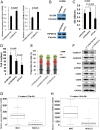miR-196b-5p-mediated downregulation of TSPAN12 and GATA6 promotes tumor progression in non-small cell lung cancer
- PMID: 32041891
- PMCID: PMC7049122
- DOI: 10.1073/pnas.1917531117
miR-196b-5p-mediated downregulation of TSPAN12 and GATA6 promotes tumor progression in non-small cell lung cancer
Abstract
Lung cancer is the leading cause of cancer-related deaths worldwide and non-small cell lung cancer (NSCLC) accounts for over 80% of lung cancer cases. The RNA binding protein, QKI, belongs to the STAR family and plays tumor-suppressive functions in NSCLC. QKI-5 is a major isoform of QKIs and is predominantly expressed in NSCLC. However, the underlying mechanisms of QKI-5 in NSCLC progression remain unclear. We found that QKI-5 regulated microRNA (miRNA), miR-196b-5p, and its expression was significantly up-regulated in NSCLC tissues. Up-regulated miR-196b-5p promotes lung cancer cell migration, proliferation, and cell cycle through directly targeting the tumor suppressors, GATA6 and TSPAN12. Both GATA6 and TSPAN12 expressions were down-regulated in NSCLC patient tissue samples and were negatively correlated with miR-196b-5p expression. Mouse xenograft models demonstrated that miR-196b-5p functions as a potent onco-miRNA, whereas TSPAN12 functions as a tumor suppressor in NSCLC in vivo. QKI-5 bound to miR-196b-5p and influenced its stability, resulting in up-regulated miR-196b-5p expression in NSCLC. Further analysis showed that hypomethylation in the promoter region enhanced miR-196b-5p expression in NSCLC. Our findings indicate that QKI-5 may exhibit novel anticancer mechanisms by regulating miRNA in NSCLC, and targeting the QKI5∼miR-196b-5p∼GATA6/TSPAN12 pathway may enable effectively treating some NSCLCs.
Keywords: GATA6; NSCLC; QKI; TSPAN12; miR-196b.
Conflict of interest statement
The authors declare no competing interest.
Figures






Similar articles
-
miR-196b-5p-mediated downregulation of FAS promotes NSCLC progression by activating IL6-STAT3 signaling.Cell Death Dis. 2020 Sep 22;11(9):785. doi: 10.1038/s41419-020-02997-7. Cell Death Dis. 2020. PMID: 32963220 Free PMC article.
-
MiR-196b-5p activates NF-κB signaling in non-small cell lung cancer by directly targeting NFKBIA.Transl Oncol. 2023 Nov;37:101755. doi: 10.1016/j.tranon.2023.101755. Epub 2023 Aug 16. Transl Oncol. 2023. PMID: 37595393 Free PMC article.
-
MiR-7-5p suppresses tumor metastasis of non-small cell lung cancer by targeting NOVA2.Cell Mol Biol Lett. 2019 Nov 20;24:60. doi: 10.1186/s11658-019-0188-3. eCollection 2019. Cell Mol Biol Lett. 2019. PMID: 31832068 Free PMC article.
-
Prospects of microRNAs as therapeutic biomarkers in non-small cell lung cancer.Med Oncol. 2023 Nov 3;40(12):345. doi: 10.1007/s12032-023-02212-5. Med Oncol. 2023. PMID: 37922117 Review.
-
MicroRNAs in non-small cell lung cancer: Gene regulation, impact on cancer cellular processes, and therapeutic potential.Pharmacol Res Perspect. 2019 Dec;7(6):e00528. doi: 10.1002/prp2.528. Pharmacol Res Perspect. 2019. PMID: 31859460 Free PMC article. Review.
Cited by
-
DNAJC12 promotes lung cancer growth by regulating the activation of β‑catenin.Int J Mol Med. 2021 Jun;47(6):105. doi: 10.3892/ijmm.2021.4938. Epub 2021 Apr 28. Int J Mol Med. 2021. PMID: 33907820 Free PMC article.
-
Combination therapy with budesonide and N-acetylcysteine ameliorates LPS-induced ALI by attenuating neutrophil recruitment through the miR-196b-5p/Socs3 molecular axis.BMC Pulm Med. 2022 Oct 26;22(1):388. doi: 10.1186/s12890-022-02185-7. BMC Pulm Med. 2022. PMID: 36289489 Free PMC article.
-
Identification of Potential microRNA Panels for Male Non-Small Cell Lung Cancer Identification Using Microarray Datasets and Bioinformatics Methods.J Pers Med. 2022 Dec 13;12(12):2056. doi: 10.3390/jpm12122056. J Pers Med. 2022. PMID: 36556276 Free PMC article.
-
miR-489-3p promotes malignant progression of non-small cell lung cancer through the inactivation of Wnt/β-catenin signaling pathway via regulating USP48.Respir Res. 2022 Apr 12;23(1):93. doi: 10.1186/s12931-022-01988-w. Respir Res. 2022. PMID: 35413838 Free PMC article.
-
miR‑491‑3p functions as a tumor suppressor in non‑small cell lung cancer by targeting fibroblast growth factor 5.Oncol Rep. 2022 Sep;48(3):164. doi: 10.3892/or.2022.8379. Epub 2022 Jul 22. Oncol Rep. 2022. PMID: 35866594 Free PMC article.
References
-
- Siegel R. L., Miller K. D., Jemal A., Cancer statistics, 2019. CA Cancer J. Clin. 69, 7–34 (2019). - PubMed
-
- Gridelli C., et al. , Non-small-cell lung cancer. Nat. Rev. Dis. Primers 1, 15009 (2015). - PubMed
-
- Ebersole T. A., Chen Q., Justice M. J., Artzt K., The quaking gene product necessary in embryogenesis and myelination combines features of RNA binding and signal transduction proteins. Nat. Genet. 12, 260–265 (1996). - PubMed
-
- Wu J., Zhou L., Tonissen K., Tee R., Artzt K., The quaking I-5 protein (QKI-5) has a novel nuclear localization signal and shuttles between the nucleus and the cytoplasm. J. Biol. Chem. 274, 29202–29210 (1999). - PubMed
-
- Chénard C. A., Richard S., New implications for the QUAKING RNA binding protein in human disease. J. Neurosci. Res. 86, 233–242 (2008). - PubMed
Publication types
MeSH terms
Substances
Grants and funding
LinkOut - more resources
Full Text Sources
Medical
Molecular Biology Databases

